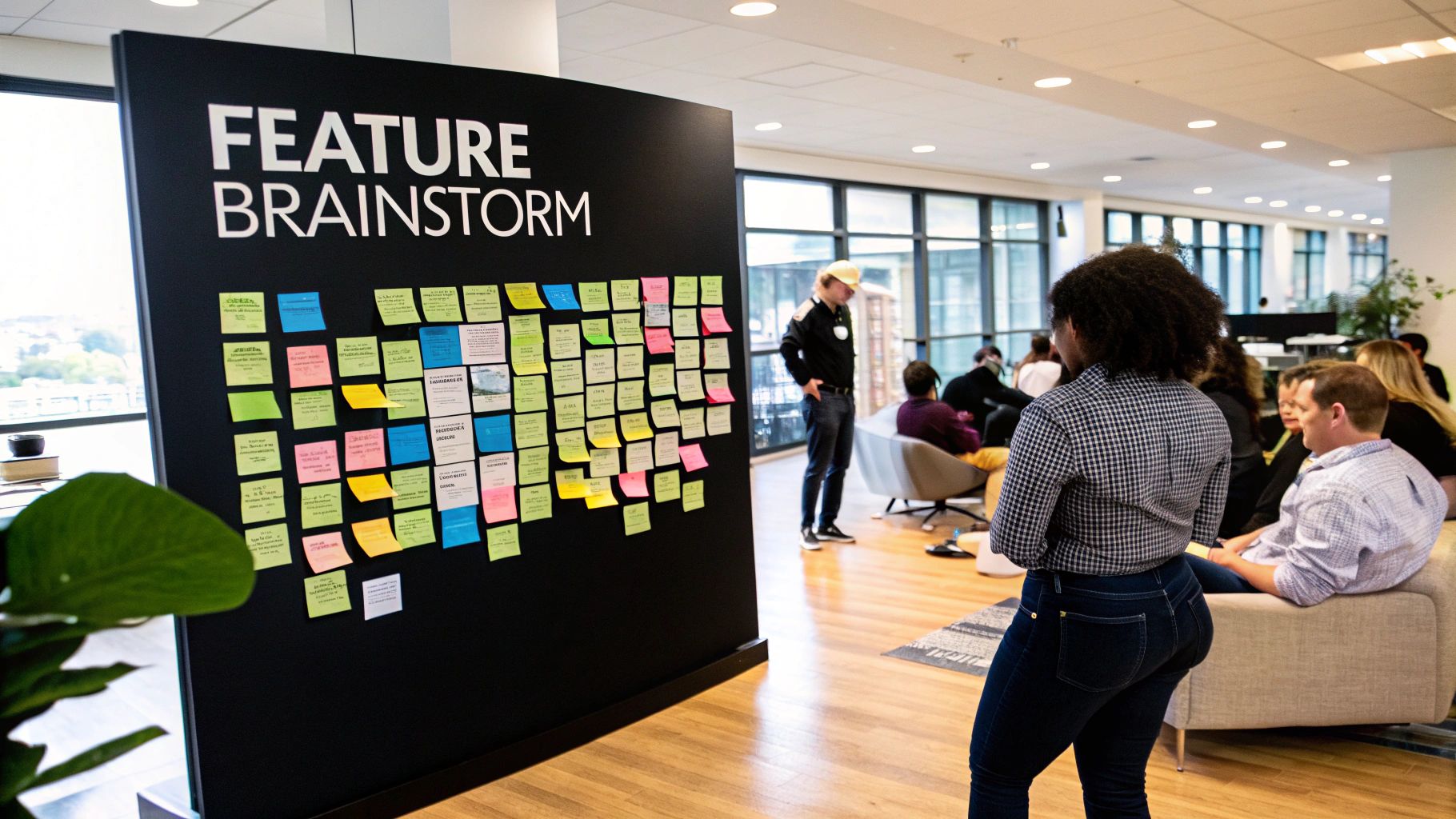How to Prioritize Product Features: A Strategic Framework for Modern Product Teams
Understanding the Science Behind Feature Prioritization

Building great products requires smart decisions about which features to build first. While it's tempting to rely on instinct, successful product teams know that data needs to drive these choices. The key is finding the sweet spot between user needs and business goals while avoiding distractions that waste time and resources.
Why Traditional Prioritization Methods Fail
Many teams still prioritize features based on personal opinions and assumptions instead of hard data. This often leads to building things users don't actually want or need. Internal teams can get caught up in their own preferences rather than focusing on real user problems that need solving.
Data-Driven Prioritization: The Key to Success
Teams that make decisions based on data consistently ship features that users value. By gathering both numbers-based metrics and qualitative user feedback, product teams can truly understand what matters most to their customers. This insight helps teams focus their efforts on high-impact features.
The RICE scoring model from Intercom has proven highly effective for prioritizing features. It evaluates options based on Reach, Impact, Confidence, and Effort. For example, if a feature would reach 100,000 users, boost engagement 20% (with 90% confidence), and take 10 person-days, its RICE score would be 1800. This systematic approach helps balance quick wins against strategic projects. Learn more about RICE scoring here: Product Feature Prioritization
Frameworks for Effective Prioritization
Several proven frameworks can guide data-driven decisions. The Kano Model groups features into Delighters, Performance Features, and Basic Features to help allocate resources wisely. The Impact-Effort Matrix maps feature impact against development effort to identify Quick Wins, Big Bets, Fill-ins, and Money Pits.
You might be interested in: Our Sitemap for more related content.
The best framework depends on your product's specific needs and goals. Testing different approaches helps find what works for your team. When combined with solid data, these frameworks give teams confidence that they're building features that truly matter to users and drive product success.
Data in Product Feature Decision Making

The best product decisions come from solid data, not just intuition. Smart teams use concrete evidence to guide their choices about which features to build. Understanding how to collect and analyze meaningful data helps ensure your product meets both user needs and business goals.
Looking at Numbers and User Feedback Together
Good feature prioritization needs both hard metrics and user perspectives. Usage stats and conversion rates show what users actually do, while interviews and surveys reveal why they do it. Together, these paint a complete picture of what features truly matter. For instance, high feature usage might hide frustration with how it works - something you'd only learn by talking to users directly.
User Research: Finding Real Problems
To build features users genuinely want, you need to dig deeper than surface requests. The Customer Problem Stack Ranking (CPSR) method helps by having users rank their issues by importance. This reveals which problems actually need solving, versus what users think they want. The goal is building features that solve real user pain points, not just checking boxes on a wish list.
Testing Impact Before and After Launch
Smart teams test potential impact before building features. This could mean A/B testing different versions or getting feedback on prototypes. Setting clear success metrics upfront helps measure real impact after launch. The numbers tell you if your prioritization choices worked, creating an ongoing learning cycle. A software company shows how this works - they used hard data to choose features that set their product apart. Read the full case study on using data for feature prioritization.
Handling Mixed Data Signals
Sometimes different data sources tell different stories. Having a clear process to evaluate conflicting information helps make sound decisions. This might mean weighing data sources based on reliability or doing extra research to validate findings. Staying objective is key, especially when stakeholders disagree. Focus on the evidence and build consensus around what the data actually shows.
Implementing Prioritization Frameworks That Actually Work

Product teams often struggle with prioritizing features effectively. Let's look at practical ways successful teams implement prioritization frameworks, including key methods, real-world adaptations, and strategies for getting team buy-in.
Choosing the Right Framework for Your Context
Different frameworks shine in different situations. The RICE model works well for data-driven teams by quantifying feature value through Reach, Impact, Confidence, and Effort scores. However, it may not capture intangible benefits like user experience improvements. The Kano Model helps teams understand user expectations by grouping features into Delighters, Performance Features, and Basic Features. For quick feature sorting based on urgency, many agile teams prefer the straightforward MoSCoW method (Must have, Should have, Could have, Won't have).
Adapting Frameworks for Maximum Impact
Most successful teams modify frameworks to fit their specific needs. For example, some adjust RICE scoring criteria to better match business goals, while others combine multiple approaches. A team might first use MoSCoW to broadly categorize features, then apply RICE scoring within priority categories for more detailed rankings. This flexibility leads to better decision-making.
Strategies for Team Buy-In and Transitioning
Getting team support is crucial when introducing a new prioritization system. Start by clearly explaining how the framework will improve product development and decision-making. Provide hands-on training and ongoing guidance to help team members feel confident using the new approach. This proactive support helps minimize resistance to change.
Avoiding Common Pitfalls
Teams often fall into common traps when prioritizing features. Relying too heavily on stakeholder opinions without data can skew decisions. Failing to update priorities as market conditions change is another mistake. Teams should regularly review and adjust feature rankings based on new information. The Customer Problem Stack Ranking (CPSR) method can help identify which problems truly need solving first. By staying aware of these pitfalls, teams can maintain an effective prioritization process.
Balancing Stakeholder Needs Without Losing Focus

Product feature prioritization requires carefully weighing different stakeholder needs while keeping user value front and center. With multiple competing demands and different views on essential features, product managers need a clear framework to make informed decisions and build agreement across teams.
Stakeholder Mapping: Identifying Key Players
Start by mapping out who your stakeholders are and understanding their influence levels. Create a simple stakeholder matrix that plots each person's interest level against their decision-making power. This visual tool helps teams identify which stakeholders need the most attention and how to best engage with each group. Focus first on high-interest, high-power stakeholders who can significantly impact the product's success.
Building Consensus: Aligning on Priorities
After identifying key stakeholders, facilitate open discussions to build agreement on feature priorities. Support your decisions with concrete user research and data. Make space for stakeholders to share concerns and provide input. When people feel heard and understand the reasoning behind choices, they're more likely to support the final priorities, even if they don't get everything they want.
Communicating Priorities: Transparency and Clarity
Clear communication maintains alignment throughout the prioritization process. Share the prioritized feature list openly, explain your criteria, and outline expected timelines. Go beyond just what was decided - help stakeholders understand why certain features took priority by connecting them to product vision and goals. This builds trust and keeps everyone moving in the same direction.
Managing Pushback: Addressing Concerns Constructively
Some pushback is normal when prioritizing features. Handle disagreements by focusing on data and finding win-win solutions where possible. If a stakeholder strongly advocates for a feature that doesn't fit current priorities, explore alternatives that address their core needs without derailing the roadmap. This might mean scheduling it for later or finding a simpler solution. Learn more in our article about how to master product prioritization.
Maintaining Focus: User Value as the North Star
Through it all, keep user value as your guiding principle. While balancing stakeholder needs matters, products succeed by solving real user problems well. Prioritize features that directly improve the user experience, even when facing pressure from stakeholders. This user-first approach ensures your product delivers meaningful value to customers and stays true to its purpose.
Building and Managing Your Strategic Product Roadmap
You've prioritized your product features - now it's time to turn them into an actionable roadmap that drives development forward. A well-crafted roadmap helps teams deliver real value while staying adaptable to changing market needs. Let's explore how to create and manage an effective product roadmap.
Organizing Features into Strategic Themes
Group related features into broader strategic themes rather than treating them as isolated tasks. For example, combine "improve checkout flow" and "add mobile payments" under the theme "Enhance Purchase Experience." This helps everyone understand how individual features connect to larger product goals. When features align with clear themes, teams better grasp the strategic purpose behind their work.
Balancing Quick Wins and Long-Term Investments
Mix smaller, immediate improvements with bigger strategic initiatives. Quick wins like bug fixes and UI tweaks show continuous progress and keep users happy. Balance these with long-term investments in major product enhancements. Like a diversified portfolio, this approach reduces risk while enabling both short-term gains and sustainable growth.
Maintaining Flexibility While Staying Focused
Your roadmap should guide development without being overly rigid. User needs, market forces, and new technologies may require course corrections. Focus on themes rather than strict timelines to stay adaptable while keeping your core objectives in view. Think of your roadmap as a compass - it points the way forward even if the exact path changes.
Roadmap Visualization and Communication
Present your roadmap clearly and visually to keep everyone aligned. Use tools like Gantt charts or Kanban boards. Tailor your message for different audiences - executives want high-level themes and timelines, while developers need detailed specifications. A well-communicated roadmap helps build consensus and set realistic expectations.
Adapting to Change: Knowing When Your Roadmap Needs Adjustment
Review your roadmap regularly against key metrics and user feedback. If goals aren't being met or market conditions shift significantly, be ready to reprioritize and update your plan. You can find more guidance on effective product prioritization here: How To Master Product Prioritization. Like recalculating a route when you hit traffic, adjust your roadmap when circumstances change.
Measuring Success and Evolving Your Approach
Product feature prioritization requires continuous monitoring and adaptation. The most effective product teams regularly assess their decisions and refine their methods based on real results. This creates a cycle where teams learn from past choices and focus resources on features that provide real value.
Establishing Clear Success Metrics
Before launching any feature, define specific metrics that connect to your original prioritization goals. For example, if you aimed to boost engagement, track metrics like session duration or user actions. Setting clear metrics upfront prevents debates about success criteria later. Make sure every metric directly ties to measurable business or user outcomes.
Creating Effective Feedback Loops
Combine both numbers and user insights to understand feature impact. Set up systems to gather usage data alongside direct user feedback through surveys and interviews. For instance, use in-app questionnaires to learn how users feel about specific features. This mix of data shows both what users do and why they do it.
Making Data-Driven Improvements
Review your data regularly and use those insights to guide future decisions. When features miss expectations, dig into the reasons why. The issue might be incorrect assumptions about user needs or problems with the implementation. For more guidance on understanding user requirements, check out: How to Master User Research. Let these findings shape how you prioritize future work.
Measuring Short-Term Wins and Long-Term Impact
Track both quick wins and strategic progress. Immediate results like higher click rates provide fast validation, while long-term metrics like customer retention show lasting value. By monitoring both timeframes, you can show how your choices create both immediate and enduring benefits.
Building a Culture of Continuous Improvement
Make prioritization a team effort. Help everyone understand why data matters for decisions and encourage open discussion about the process. Review and update your methods based on team input. When the whole team contributes to and believes in the process, it leads to better outcomes.
Keep your code quality high and development smooth with Pull Checklist. Our GitHub app handles code reviews automatically and helps teams follow best practices. Learn how Pull Checklist can improve your development process.
